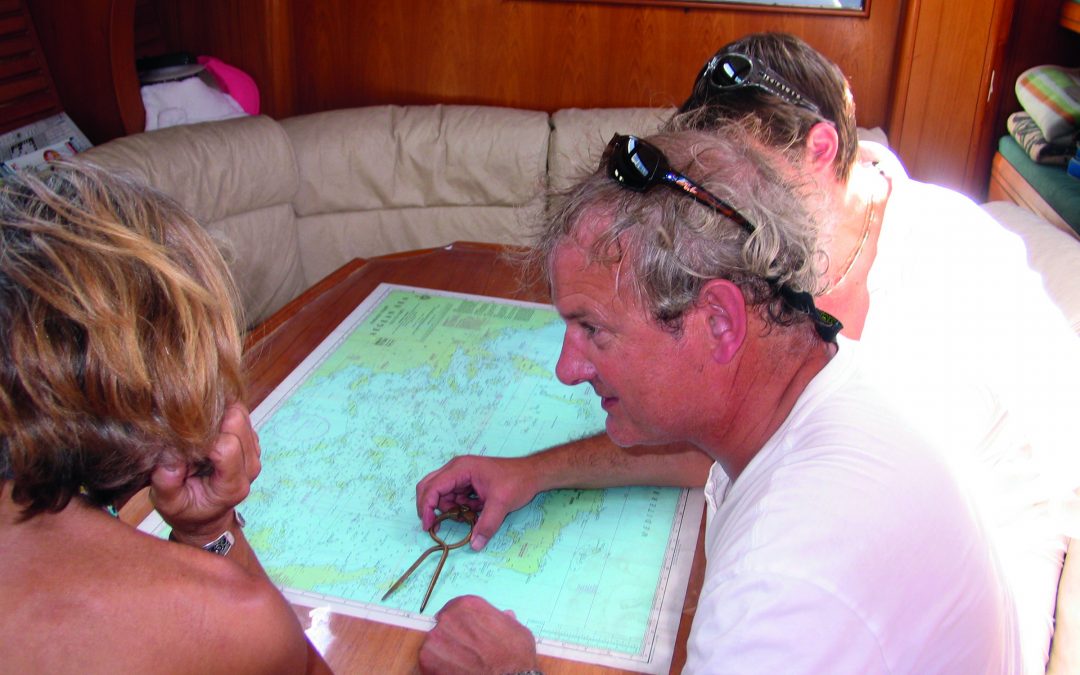Yachting Safety Briefing
Down below
Lifejackets and harnesses – fitting, when to wear, clipping on
Gas – risks, precautions, gas bottles and taps
Fire prevention – extinguishers, fire blanket, where and how to use
Moving around – companionway, handholds, galley safety
Heads – how to use
Seacocks – location of
Hatches – opening and closing, risks
VHF – how to use
Engine – basic operation
Batteries – location
On deck
Hazards – boom, tripping, slipping, hatches
Clipping on – jackstays
Heaving line
Engine controls
Instruments
Lockers – contents
Winches and clutches – safe operation
Anchor – safe operation
Emergency at sea
First aid – kit location
MOB – equipment – throwing line, horseshoe buoy, Dan buoy
Flares – where, when and how to use
VHF – emergency procedure
EPIRB – how to activate
Liferaft – where, when and how to launch
Grab bag – where, contents
Steering failure – emergency tiller, where and how
Flooding – seacock failure, plugs. Bilge pumps. Bailing.
Crew welfare
Seasickness – what to do, how to avoid
Food and drink – use of galley
Kit – stowage
“One hand for you – the other for the boat!”
This post is an extract from the Safe Skipper App for iPhone & Android.
Essential Knots: Round turn and two half hitches
The VHF DSC Radio jargon buster
Steel and Aluminium Hulls
The two metals used for hull construction are steel and aluminium. These are both very strong materials and will last a long time as long as they are cared for, which primarily means protecting steel boats from rust and aluminium boats from electrolytic action.
Weather forecasting resources and tips
All competent sailors need to have a good basic understanding of how to interpret a weather forecast. They also need to be able to interpret the actual conditions they are experiencing.
Antifouling for leisure boats – Part 2
To prepare for antifouling, as soon as your boat has been lifted out and pressure washed, you need to check all the surfaces of the hull below the waterline, remove any remaining barnacles and check for blisters.
Boat electrics
All boat owners should have a basic knowledge of electrics, both to avoid encountering electrical problems at sea and to stand a chance of solving them should they occur.
Jester Challenge 2022 – Sailing single handed from Plymouth UK to the Azores: Part 7 – Motivation
Jester Challenge – A modern experiment in old-fashioned self-reliance, self sufficiency, and personal responsibility. This is the seventh of a 10-part post where solo sailor, Bernie Branfield, shares his first-hand account of his single-handed, 2022 Jester Challenge, from Plymouth, UK to the Azores, in his 26′ Invicta Mk2, Louisa.
Sending distress signals
In an emergency situation at sea, it is a top priority is to know how to send and receive emergency radio calls and alert others of your predicament. Likewise, if you receive a distress signal, you must be ready to go to the help of others.
Seasickness – how can you prevent it?
Essential Boat Safety Briefing
Always have an emergency ditch bag ready to go…
Tools and spares for your boat
Tools and Spares to take to sea!
You won’t regret taking a look at our essential tips and checklist to make sure you’re prepared for routine maintenance and those unexpected jobs that come up whilst you’re afloat!
Navigation safety: a quick-reference mobile app to learn the ColRegs NavLights and Shapes
Winch Servicing
Essential yacht tender safety for skippers and crew
Fixing position at sea using traditional methods
This post looks at some traditional methods used for fixing a vessel’s position at sea, within sight of land. Electronic fixes using chart plotters are very straightforward to record, but if for some reason a vessel’s electronics are faulty it is essential that a skipper knows how to use traditional methods.
Boat engine fuel system
If engines are installed and serviced correctly then most marine engines are very reliable, but one of the most important parts of the engine to check and service is the fuel system.
Jester Challenge 2022 – Sailing single handed from Plymouth UK to the Azores: Part 8 – Arriving at the Azores
Jester Challenge – A modern experiment in old-fashioned self-reliance, self sufficiency, and personal responsibility. This is the eighth of a 10-part post where solo sailor, Bernie Branfield, shares his first-hand account of his single-handed, 2022 Jester Challenge, from Plymouth, UK to the Azores, in his 26′ Invicta Mk2, Louisa.
Essential boat engine checklist
Essential Knots: Clove hitch
Keel design – options to consider when choosing a yacht
Anchoring – getting it right
Boat maintenance below decks
While most interior maintenance work can be done when a boat is afloat, some jobs such as servicing the seacocks have to be done ashore. It makes sense to do any major interior repairs and improvements with the boat hauled out in the boatyard.
Boat electrics inspection checklist
With the boat ashore, here are some recommendations for carrying out a boat owner electrics inspection. Safety is always paramount so remember to do the checks with the batteries off. Wearing a head torch helps, make notes as you go and only tackle a repair if you are 100% sure you know what you are doing:









